When Ford introduced its new rear-wheel-drive, sub-compact Pinto for 1971, their tagline was The Little Carefree Car. It enjoyed a 10-year run that saw more than three million units built. And it was still selling decently when it gave way to the front-wheel-drive Escort for 1981. This extremely clean Pinto Wagon from 1977 has an astonishingly low 39,000 miles. Because most of these cars were used, abused, and then thrown away, you seldom see one turn up this nice. It’s priced at $8,500 here on Facebook Marketplace in Ontario, California.
The domestic automakers were rolling out sub-compacts in the early ‘70s to compete with the imports. Chevy had the Vega and Ford had the Pinto. The Pinto would turn out to be the sales winner between the two and Mercury cloned the car for 1974, calling it the Bobcat. The car would be especially popular when gas prices went up after the OPEC oil embargo, but the Pinto got into trouble over its own safety record. The Pinto’s fuel-tank design and placement attracted media and government attention after several deadly fires occurred related to the tanks exploding during rear-end collisions.
The seller refers to this 1977 Pinto as a “total barn find” but we don’t see a barn in sight. What we do see is a really well-kept car that has seen little use as perhaps a second or third car. It looks nearly flawless except for maybe a small, small dent on the rear hatch door. It has no doubt escaped the wrath of rust by being a California-based vehicle. Like all Pinto’s for 1977, the seller’s car received the series’ first significant styling update with slanted back urethane headlamp buckets, parking lamps and grille. But what’s with that cow-catcher of a bumper in the back? That thing is huge and would certainly serve as a bench for two at a tailgate party.
We believe the engine is the 140 cubic inch inline-4 that put out between 80-90 hp. The seller says it has recently been “completely” serviced, which we assume is a fancy way of saying a tune-up and oil change. We’re told it runs great and has a new set of tires to roll on. And you’ll tool around in comfort with A/C that works well. Ford sold about 225,000 Pinto’s in 1977 and i hasn’t really reached collector status, so they’re priced as used cars. NADA says that $8,000 (really?) is top dollar, so the seller isn’t way out of line, but I’m not sure that a Pinto would be my first (or fifth) choice if I had eight grand to spend on a spare car.






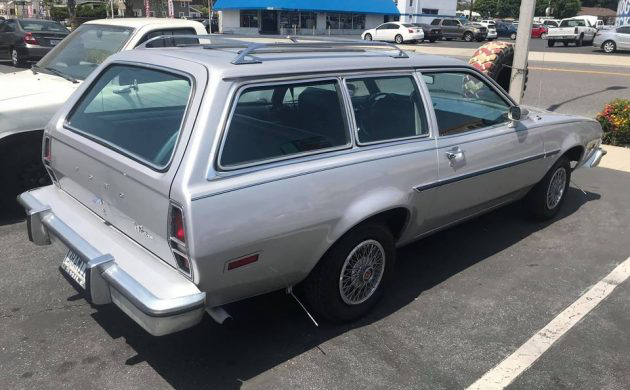
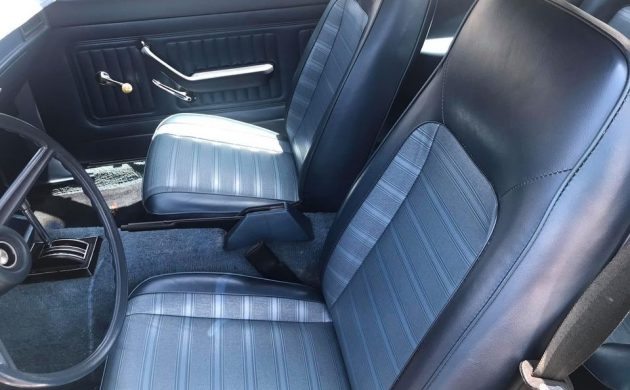
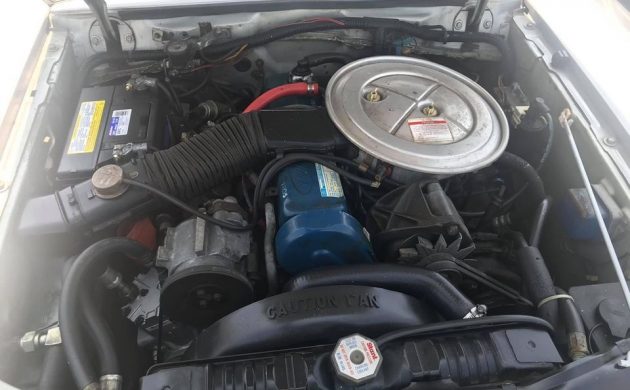

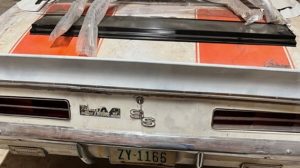
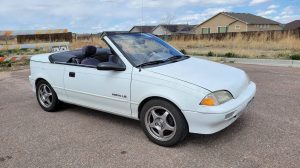



Obviously this Pinto has been loved for decades. It’s even a wagon, wagons now being popular collectibles. For the people who would like to have nice one, this price probably isn’t far off.
Whoever buys it should be ready: at the local cruise-in, or even for stops at the gas station or Home Depot, be prepared for folks who approach you and want to talk about their experiences with a Pinto. Many people (including me) had good experiences with them. Yes they were cheap economy cars, but overall they did their job fine.
I had a ’74 hatchback, and though 17 year old me thoroughly abused it, it, as you said, served me well.
If I’m not mistaken (and I very well could be), that huge rear bumper was a weak effort by Ford to “protect ” the gas tank.
Federal bumper regulations were in effect and were the primary reason for the big front and rear bumpers, on all cars. Perhaps there was an associated effort with the bumpers that related to the gas tank, but I doubt it.
Exactly. The gas tank wasn’t a problem in the station wagons. It was the runabouts that had issues with being rear ended. Most of the bad reputation came from the big three television networks that embellished the truth. Much like the stigma the Pontiac Fiero got in the next decade.
As I recall, the Pinto wagon did not suffer from the gas tank puncturing problem in rear end collisions. The huge bumper was to meet federal 5mph bumper regs. Ford bumpers on their 1970s cars tended to be ginormous even by the standards of the day.
The station wagons, the sedan delivery and the Cruising Van weren’t affected by the gas tank situation. Their fuel tank and filler design were much different from the one on the sedans and hatchbacks, which were recalled.
Some reasonable bumpers and a third pedal would make this an interesting car.
Best sleeper car…Pinto with and SVO drivetrain. Other than needing an ECU it’s a nearly direct bolt it. The engines were from the same basic architecture!
I had a Pinto wagon in ’74 or so, bought new with a stick in a bright electric blue. I loved that car; my wife didn’t, so off it went after a year or so!
I used to have a pinto till it blew up . I was just smoking a cigar working on a leaking fuel line and never could figure out why 😜(kidding)
Seriously older folks remember the pinto lawsuit of one blowing up from a rear end accident and claims… but aren’t all older cars dangerous? Corvair? Dual gas tank Chevrolet 80s pickups with tanks outside the frame by fenders allowing impacts. My 67 mustang trunk floor is my gas tank…we’ve all heard stories of rear end accidents where folks sprayed with fuel ..
https://www.google.com/amp/s/www.harrybrownlaw.com/blog/the-10-most-dangerous-cars-of-all-time-infographic%3Fhs_amp%3Dtrue
Most cars back in the day had the gas tanks behind the rear axle and vulnerable to collision. However I think the Pinto’s problem mostly had to do with bolts on the differential puncturing the gas tank in relatively low-speed collisions, a problem not shared with most of its contemporaries.
Another problem with the Pinto’s fuel tank design was the filler tube was just barely long enough to stay located the tank. When the car was rammed from the rear the filler tube would pop out of the tank and whatever fuel was inside would gush out.
Not only that, the bumper mounting bolts could also puncture the tank.
The recall kit included hard plastic shields to mount at the front and rear of the tank. There was also a longer filler tube with three Torx screws to mount it to the quarter panel. When looking at a 71-76 Pinto, remove the gas cap and check for the three Torx screws. If you find four Phillips screws, that car was never recalled.
Since Corvair is mentioned here, the Corvair WAS NOT intrinsically unsafe. As long as owners maintained the 11 pound differential between its front (15/19lbs) and rear (26/30lbs) tires, the Corvair’s handling remained friendly and innocuous. However, most Drivers’ are not known for monitoring tire pressure. Gas station attendants, in the day, had a mantra: “24 pounds all around.” In 1972, the National Highway Traffic Safety Administration issued a report exonerating the Corvair from Nader’s accusations but, by then, the damage was done.
If the first generation Corvair’s rear suspension was so wonderful, why did GM go to a complete redesign for the later models?
Actually this reply is for Rick. The first generation Corvairs suspension was better than most in their day, it was just the mind set of drivers, that’s still actually a problem today. But like posted above the tire pressures were strictly to be at least 10 psi more in the rear due to the rear weight bias, that was unique on only the rear engine powered cars. But add any new modern radial tires on any year Covair to see the real handling potential! Plus the last year production of the first generation, 1964, Chevy added a transverse leaf spring from one wheel to the other in the rear, that cured the swing axle issues!
First of all, “those” GM pickups that Dateline on NBC (or whatever that show was called) tried to make everyone believe were soooooo dangerous, were built from 1973-1987 and some models all the way through the 1991 model year. Not all of them had dual tanks either. Secondly, let me state that I feel safer driving ANY of my “square body” trucks than I do anything built today. NBC actually admitted later to using pyrotechnics in their video so that it would look like the truck really exploded.
As for the Pinto, I’ve never owned one but I know many people that have. For the most part, they all loved them. I know that people died because Ford did a few things wrong and I feel bad for their families. It’s just getting old reading comments about exploding Pintos every time one comes on the site. Black light comments about custom vans and “Family Truckster” comments on station wagons are just as bad.
OK, because no one has read up on it and we had to as engineering students at the time: The wagon was not a fire problem as it had a full floor in the back above the fuel tank. The Pinto Runabout Hatch back was also not a problem. The problem was the standard Pinto sedan. In the sedan the gas tank was the floor of the trunk space and the fuel filler tube ran directly from the fender down into a grommet type seal in the top of the tank. When hit from behind, the tank was dislodged and the filler tube came out. Fuel would then spray the interior because the cardboard seat back was the only separation between the trunk and the interior. The wagon and the runabout shared a full floor and an indirectly router filler neck that bent down within the fender to clear the hatch/wagon floor. It was determined that using the wagon filler neck would have prevented the fire incidents as the neck would have not dislodged. The additional cost was why Ford chose not upgrade to the extended filler neck at a cost of about $0.90 per vehicle (do the math. On the run of Pintos and the very tight profit margins on small cars it was).What killed them in court was the decider that they would pay less in survivor payouts than they would pay to fix the problem. Survivor means to the family of the deceased because the fire would always kill the car occupant. Then the unanticipated happened. The driver survived with horrible disfiguring burns, and came to court. Ford failed to argue widows and orphans lived on the profits of the stock. Had they, they might have been able to justify their reasoning. But the jury, faced with the melted looking teen driver hit them with the biggest product liability judgment in history, $125,000,000.00, equivalent to Ford’s annual corporate profit for the year.
I was a Ford dealer repair tech when the Pinto gas tank campaign began. The sedan, the runabout and the hatchback were recalled. The station wagon, the sedan delivery and Cruising Van were’t recalled because their tank and filler tube were of a different design.
Thank you Arthur, and I think Ford deserved what they got if not more. There is no excuse for by passing the safety of occupants for the sake of ninety cents.
Hmm, I can’t say whether or not the gas tank in my 78 Mercury Bobcat was actually the rear hatch floor. It never dawned on me to notice that until now that it has been brought to light.
This is a bargain. I just completed a total resto on a 77 fully loaded Squire. Like any old car, one is always advised to purchase the absolute best example money can buy, because it will be cheaper in the long run. (Stupid me always does the opposite.)
Anyway, I’ve been following Pinto Wagon prices, and some perfect examples have gone for insane money (20-30k).
They are fun little cars, and with a T-5 swap, are completely capable of current highway speeds at a reasonable RPM.
My only disappointment with this car is that it is a base model, low spec, boring color combo. The fake wood, orange plaid, roof rack wearing sport appearance package wagons is where the money is right now
My family knew the family of the girls killed in that Indiana crash so any discussion of Pintos hits home for me. Thanks to those who were kind in their comments.
Absolutely. The loss of life based on corp greed is atrocious. And Ford paid the price and all car designs going forward benefited from the results- with cars safer than ever, and companies not daring to do this again.
That being said, there is an interesting discussion regarding the actual engineering and design flaws, as well as the actual vs perceived extent of the risks associates with the car that should take place, with no disrespect to the victims.
Curb feelers on a Pinto? I never cease to be surprised by what I see on here!
I purchased a brand new 1977 Black Pinto Wagon with a 2.3 OHC with a 4-speed. I de-chromed the entire car. It had the rally wheels and a factory tach as factory options.
Unfortunately it was a piece of junk. Engine let go at 42K (factory forgot to drill an oil passage and it spun the bearings). Ford said 12 months or 12k miles was the warranty so I had to buy a new short block. Soured me on the car so I sold it.
The Pinto and Vegas, when running well we nice little cars, much more fun to drive then these fwd econo boxes today! I also believe the Pinto wagon had no gas tank issue like the hatchbacks did.
For years, I’ve wanted to swap the drivetrain from a Thunderbird Turbo Coupe into a Pinto. I’m sure it’s been done many times but it would make a really fun driver.
Had a 78 Mercury Bobcat wagon, bright yellow with the wood panel stickers all around. Had the German V6, wasn’t real fast, but it had some ommph and decent gas mileage.
It is fun. I have a 2.3 turbo out of a 84 Turbo Coupe in my 90 Mustang LX with injectors, VAM, and computer out of a 88 Turbo Coupe. It cruises at 70 easy. Though they are finicky at running a little higher in temperature with stop and go conditions; although, mine is not connected to its intercooler since I am not trying to race it every time. One day, I’ll hook up the piping to the intercooler just for comparison. I kind of like it without the piping due to there being more room in the engine bay.
Looks just like the car my family had when I was a teenage driver and college student. Ours was a gray 1977 wagon like the pictured car but with a red interior instead of the blue/gray interior pictured. My father bought it used in the fall of ‘79 from his company’s service technician fleet. I learned to drive with it in ‘80 and it eventually became my college car from ‘84 to ‘87, when I junked it with 119K miles (the suspension was failing). One problem the car has was paint peeling so the red primer was exposed. It was a common problem with other 1977 gray Ford cars like Granada’s and LTD’s.